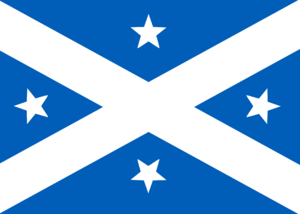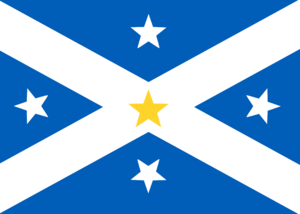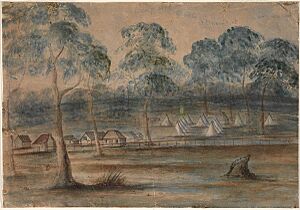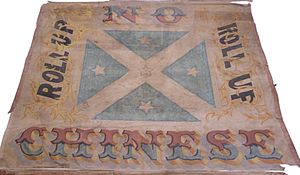Lambing Flat facts for kids
Lambing Flat was the name of a gold field in New South Wales, Australia. It is most famous for a big protest against Chinese miners that turned into a riot. This happened on the night of June 30, 1861. It was one of several protests on the Burrangong goldfields between late 1860 and late 1861. The riot at Lambing Flat was one of the most violent.
Contents
Why Miners Disliked Chinese Miners
In the 1850s, many European miners on the goldfields did not like the Chinese miners. Most of the problems came from how the Chinese looked for gold.
The gold found was called alluvial gold. This meant it was small pieces of gold mixed with soil and clay close to the surface. It was found in very old river beds that had been buried for thousands of years. Finding this gold did not need much skill. But it was very hard work.
European miners usually worked alone or in small groups. They often moved from one area to another. Many miners did not find enough gold to earn a living. Only a few became rich.
The government made miners pay a "Miner's Licence". This was a tax they had to pay to be allowed to dig. They did not pay for the gold they found. Miners did not like this tax. There were several angry protests. The most famous was the Eureka Stockade in Ballarat, Victoria. More than 30 miners were killed there.
The Chinese miners usually worked in large groups. These groups could have 30 to 100 men. They shared the small amounts of gold they found. They often looked for gold on land that other miners had already searched. European miners thought this land was still theirs.
Chinese miners lived and worked closely together. Most of them had been farmers in China. They were used to working long hours. They were also used to simple food and housing. They were happy to find many small pieces of gold. They were not always looking for one big piece that would make them rich.
The first public protest against Chinese miners happened in Bendigo in July 1854. This was an attempt to stop Chinese miners from working there. Fights also broke out between European and Chinese miners. This happened in places like Daylesford and Castlemaine.
A group of Chinese miners found gold at Ararat. They were on their way to the Victorian goldfields. European miners forced them off this new goldfield. Similar events happened in New South Wales. European miners forced Chinese miners off the diggings at Rocky River in 1856. Serious fights took place at Adelong in 1857. Another big riot happened at the Buckland River goldfield in July 1857.
Trouble at Burrangong in 1860
There were not many Chinese miners in New South Wales at first. Victoria had made it harder for Chinese people to enter. They had to pay a tax of £10. So, Chinese miners started coming to New South Wales instead.
In 1860, the Chinese and British governments signed an agreement. It was called the Convention of Peking. This agreement meant that Chinese and British people would have the same rights in each country. Australia was a British colony. So, New South Wales could not stop people from China from coming.
A new law was being discussed in the parliament to control Chinese immigration. This was happening when the first gold miners arrived at Burrangong.
Problems started in 1860. Miners formed a group called the Miners Protective League. European miners held large meetings. They wanted to force the Chinese to leave the goldfields. They would put up signs telling the Chinese to go. At first, most Chinese miners moved to another part of the goldfield. Some came back soon after. This happened several times over eight months. As long as the Chinese stayed in certain areas, the European miners would accept them.
The Lambing Flat Riot
The Lambing Flat riot happened on the night of June 30, 1861. About 3,000 miners marched to Lambing Flat. They were led by a brass band. Two men carried a special banner. They forced the Chinese miners to leave Lambing Flat.
The rioters set Chinese tents on fire. They smashed or stole items belonging to the Chinese. Then they went to the Back Creek diggings. There, they set fire to more tents. Many Chinese miners were hurt, but no one was killed. About 1,200 Chinese miners left the area. They set up a camp about 20 km away.
Two things caused the riot to start. First, the Parliament in Sydney did not pass the anti-Chinese laws. Second, a false story spread around the goldfields. The story said that 1,500 new Chinese miners were coming to Burrangong.
The police arrived at Burrangong a few days later. They arrested three of the riot leaders. The miners were angry. On the night of July 14, 1,000 miners attacked the police camp. The police fired their guns. One miner was killed, and many were hurt.
The police had to leave. A group of 280 soldiers, sailors, and extra police came from Sydney. They stayed on the goldfields for a year. The Chinese miners came back. They lived in a separate part of the diggings. The leaders of the riots were arrested. Two were sent to jail. By the end of the year, Burrangong was quiet. The Chinese miners were still there.
Some Chinese miners asked the New South Wales Government for money. This was to make up for their losses in the riots. But it is not clear if they ever received any money.
The Lambing Flat Banner
A special banner from this time is now on display. It is at the Lambing Flat museum in Young, New South Wales. It was painted on a tent-flap in 1861. The banner shows a Southern Cross symbol. It is placed over a St. Andrew's Cross. The words "Roll Up – No Chinese" are written on it. Some people say this banner is like a version of the Eureka Flag. It was used to advertise a public meeting. This meeting happened just before the famous Lambing Flat riots later that year.
See also
- Buckland Riot, 1857
- White Australia policy
- San Francisco riot of 1877 in United States
- Rock Springs massacre, 1885 in United States
- Attack on Squak Valley Chinese laborers, 1885 in United States
- Tacoma riot of 1885 in United States
- Seattle riot of 1886 in United States





